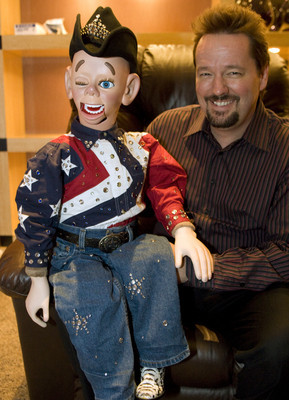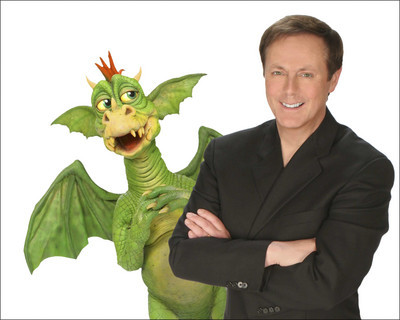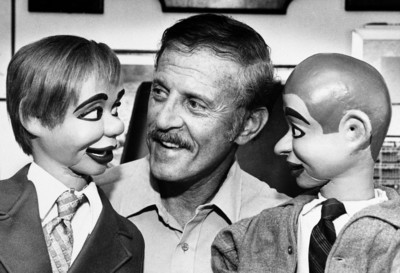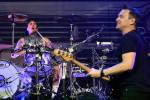Once passe, ventriloquists are attracting crowds, ratings and awards
"Oh, no. A ventriloquist."
In one exasperated exclamation, actor and "America's Got Talent" judge David Hasselhoff spoke for an entire generation of Americans who've seen one too many ventriloquists try to not move their lips in the service of delivering one too many lousy jokes.
Of course, Hasselhoff retracted his sour prognosis after he saw Terry Fator do his thing. Not only did Fator walk away with the competition's million-dollar grand prize, he earlier this month premiered his show at The Mirage, in what surely is the highest-profile gig a ventriloquist has ever had in Las Vegas.
Consider it the beginnings of what could be a new era of respectability for a performing art long burdened in the American public eye with the triple-threat stereotype of corniness, uncoolness and, even, a vague hint of creepiness.
Ventriloquism, believe it or not, has become hip.
Fator's run at The Mirage is only the start of it, too. Consider, also, that the premiere telecast of Jeff Dunham's Christmas special -- the ventriloquist's resume includes shows at Caesars Palace, Monte Carlo, Sands and the Sahara -- earned the highest ratings ever for a Comedy Central show.
And, for a dash of serious artistic cachet: Ventriloquist Jay Johnson, best known for his starring role on the '70s sitcom "Soap," won a 2007 Tony award for his one-man Broadway show, "Jay Johnson: The Two and Only!"
"Absolutely, there is a huge resurgence" in ventriloquism, Fator agreed last week, noting that puppet makers have told him that they're selling 10 times as many puppets as they did before his "America's Got Talent" run.
"It's really cool to see it back," Fator continues. "I think what's happened is that we had a drought where pretty much any ventriloquist you saw maybe 20 or 30 years ago was just terrible. So people began expecting 'terrible' when they'd see a ventriloquist."
Then, in recent years, practitioners such as Dunham, Las Vegas veteran Ronn Lucas and Fator have "shown people ventriloquism is not just for children, but can be really wonderful entertainment for all ages," Fator says.
Johnson says ventriloquism also owes its current high public profile to the existence of more nationwide venues to see it.
"When you talk about ventriloquism's heyday in the '50s and early '60s, Ed Sullivan was a major part of that," Johnson explains. "He used every ventriloquist, every novelty act, every plate spinner in the world, so there was a place to showcase that kind of talent."
But, by the time Johnson appeared on "Soap," Sullivan's weekly variety TV show had disappeared and, with it, a prime stage for ventriloquism. Johnson says it wasn't until the advent of such reality/variety hybrids as "America's Got Talent" that ventriloquists and other such Sullivanesque acts again could benefit from a national showcase.
Also helpful in increasing ventriloquism's exposure has been the Internet, where clips of Fator and Dunham, along with such earlier practitioners as Paul Winchell, can be accessed with the click of a mouse. Dunham in particular, Johnson notes, has been "very successful in using YouTube and the Internet to circumvent what had been the traditional way to make it up, through network TV."
It's even possible that the relative obscurity of ventriloquism during the previous decade or two may have contributed to its current popular resurgence. Johnson says ventriloquism is now where stand-up comedy was "maybe 15 years ago (when), if you could do anything, you'd be a stand-up comic. I think, now, people are looking for something a little more novel."
But the most significant reason ventriloquism is back is because its current headliners -- Fator, Dunham and Johnson -- have taken the art to a level far beyond lame comedy routines.
When Hasselhoff voiced his reflexive dismissal, "I loved it," Fator admits, because "they were not going to be expecting a really good ventriloquist. And the reason he did that is he'd seen so many bad ventriloquists. He even told me afterwards there had been 10 awful ventriloquists who tried out that year. He said, 'I was so sick of seeing ventriloquists.'
"When he did that, I thought, 'Oh, I've got him.' "
Fator floored Hasselhoff -- and, given audience votes, the rest of America -- by his ability to combine three distinct performance arts: ventriloquism, singing and doing impressions. (During his first appearance, his puppet did an impression of Etta James singing "At Last," and his characters also do impressions of Roy Orbison, Tony Bennett and James Taylor.)
"If you're doing corny, silly jokes, nobody has any use for that now," Fator says.
Similarly, puppet characters have moved beyond the standard-issue, generic figures a la Edgar Bergen's Charlie McCarthy. Fator's roster of puppet characters includes a cougar -- the feminine pop culture kind, not the wild animal kind -- and he says he's working on a gay character. Then, for way-out-of-the-box edgy, Dunham's "Achmed the Dead Terrorist" puppet ("Silence! I kill you!") is so popular it has become a ring tone.
But, in creating a new audience, Fator, Dunham et. al. may have to educate a generation of audiences who grew up with no Edgar Bergen, Shari Lewis or Paul Winchell of their own. Johnson found while doing his show that some younger people weren't even familiar with the phrase "throwing your voice."
"That was a real generational thing," he says. "We had to educate people just about the term."
But what remains is the sheer novelty of seeing human thoughts expressed by a not-technically-human figure. Winchell once told the Los Angeles Times that he couldn't foresee a future for ventriloquism in an age when computer imagery can make anything talk. But that may be just the point.
"It doesn't matter what kind of technical advances you make. There's still something about seeing a guy bring an inanimate object to life in front of you," Fator says.
"Really, we're illusionists. We take wood and felt and we create life, and that will always hold a fascination. It just has to be done well. In an age in which you can get entertainment from any source, you really have to make sure you up your game, and I think that's what we have done."
Not even a videotaped performance can convey that impact, "where a little puppet can comment on something happening onstage like a human would," Johnson says. "You don't really get a sense of how immediate this art form is and how compelling this art form is."
"Yes, you can make anything talk, but you can't make it live," Johnson says. "Ventriloquists, as artists, transcend that."
Contact reporter John Przybys at jprzybys@ reviewjournal.com or 702-383-0280.































